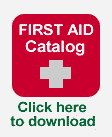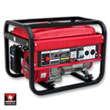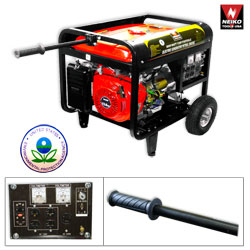| Portable generators are useful when temporary or remote electric power is needed, but they also can be hazardous. The primary hazards to avoid when using a generator are carbon monoxide (CO) poisoning from the toxic engine exhaust, electric shock or electrocution, fire and burns.
Every year, people die in incidents related to portable generator use. Most of the incidents associated with portable generators reported to CPSC involve CO poisoning from generators used indoors or in partially-enclosed spaces.
Carbon Monoxide Hazards
When used in a confined space, generators can produce high levels of CO within minutes. When you use a portable generator, remember that you cannot see or smell CO. Even if you do not smell exhaust fumes, you may still be exposed to CO.
Danger labels are required on all portable generators manufactured or imported on or after May 14, 2007.
If you start to feel sick, dizzy, or weak while using a generator, get to fresh air RIGHT AWAY. DO NOT DELAY. The CO from generators can rapidly kill you.
Follow these safety tips to protect against CO poisoning.
- NEVER use a generator inside homes, garages, crawlspaces, sheds, or similar areas, even when using fans or opening doors and windows for ventilation. Deadly levels of carbon monoxide can quickly build up in these areas and can linger for hours, even after the generator has shut off.
- Follow the instructions that come with your generator. Locate the unit outdoors and far from doors, windows, and vents that could allow CO to come indoors.
- Install battery-operated CO alarms or plug-in CO alarms with battery back-up in your home, according to the manufacturer’s instructions. CO alarms should be certified to the requirements of the latest safety standards (UL 2034, IAS 6-96, or CSA 6.19.01). Test batteries monthly.
To avoid CO poisoning when using generators:
- Never run generators indoors, including garages, basements, crawlspaces and sheds.
- Get to fresh air right away if you start to feel dizzy or weak.
Electrical Hazards
- Generators pose a risk of shock and electrocution, especially if they are operated in wet conditions. If you must use a generator when it is wet outside, protect the generator from moisture to help avoid the shock/electrocution hazard, but do so without operating the generator indoors or near openings to any building that can be occupied in order to help avoid the CO hazard. Operate the generator under an open, canopy-like structure on a dry surface where water cannot reach it or puddle or drain under it. Dry your hands, if wet, before touching the generator.
- Connect appliances to the generator using heavy-duty extension cords that are specifically designed for outdoor use. Make sure the wattage rating for each cord exceeds the total wattage of all appliances connected to it. Use extension cords that are long enough to allow the generator to be placed outdoors and far away from windows, doors and vents to the home or to other structures that could be occupied. Check that the entire length of each cord is free of cuts or tears and that the plug has all three prongs. Protect the cord from getting pinched or crushed if it passes through a window or doorway.
- NEVER try to power the house wiring by plugging the generator into a wall outlet, a practice known as “backfeeding.” This is extremely dangerous and presents an electrocution risk to utility workers and neighbors served by the same utility transformer. It also bypasses some of the built-in household circuit protection devices.
Fire Hazards
- Never store fuel for your generator in the home. Gasoline, propane, kerosene, and other flammable liquids should be stored outside of living areas in properly-labeled, non-glass safety containers. Do not store them near a fuel-burning appliance, such as a natural gas water heater in a garage.
- Before refueling the generator, turn it off and let it cool down. Gasoline spilled on hot engine parts could ignite.
Source: https://www.cpsc.gov/cpscpub/pubs/portgen.html
Please review FEMA's emergency planning regarding installation & use of a generator:
What You Can Do
Protecting your business from disasters caused by natural hazards can involve a variety of actions, from inspecting and maintaining your buildings to installing protective devices. Most of these actions, especially those that affect the structure of your buildings or their utility systems, should be carried out by qualified maintenance staff or professional contractors licensed to work in your state, county, or city. One example of disaster protection is installing a generator to provide electricity during power outages.
Install a Generator for Emergency Power
Power outages are commonplace during disasters, and they may last for several days. As a result, even businesses that are not severely damaged can suffer losses because of the interruption of normal operations or the loss of perishable stock. You can reduce these losses and speed the recovery process by installing an emergency generator. First, determine which systems and equipment are essential to the continued operation of your business. They may include one or more of the following:
- Heating, ventilation, and air conditioning (HVAC) systems
- Industrial equipment and major appliances, such as refrigerators and freezers
- Lights (interior and exterior), computers, and other office equipment
- Pumps, including sump pumps, sprinkler system pumps, and well water pumps
- Alarm systems
Once you have identified the essential systems and equipment, determine how much power they require. Then check with a generator sales representative regarding the appropriate size and type of generator. The sales representative can also help you select other components of the emergency power system, including the main transfer switch and the electrical panel.
Tips
Keep these points in mind when you select and install a generator:
- Protect your generator and its fuel tank from flooding and high winds. In flood hazard areas, mount the generator and tank securely on concrete platforms, above the expected flood level. Install the generator and tank inside or next to a building or protective structure to shield them from wind and windborne debris. Electrical and fuel supply lines must also be protected. And remember that your generator must be accessible for maintenance and that exhaust gases must be routed to the outside if the generator is installed in an enclosed area.
- Some systems and equipment may have to operate continuously (refrigerators for example), while others may be needed only during normal business hours (such as office equipment).
- You will need more power to restart systems and equipment when the power fails than to continue operating them after startup. The generator you choose must be able to meet both of these needs. (You can minimize the power requirements for startup by starting individual systems and equipment in sequence rather than all at once.)
- Before you buy a generator, ask your utility company if it has regulations that govern the use of emergency power equipment. Also, the installation of the generator and all wiring, switches, and other electrical components must meet the requirements of your local electrical code.
- Be sure to maintain an adequate supply of fuel. Your sales representative should be able to tell you the generator’s rate of fuel consumption at various power output levels.
- Follow the manufacturer’s recommendations for routine maintenance of your generator.
Estimated Cost
The cost of a generator will depend on the types and amount of equipment and systems that need to be powered, the requirements of local codes and utility companies, the type of generator you choose and its specifications (amperage, voltage).
Source: https://www.fema.gov/plan/prevent/howto/how2022.shtm
CPR Savers & First Aid Supply is your source for emergency supply products such as portable generators for emergency preparedness in the case of disaster, hurricane, flood, or fires.
|


![]()
















